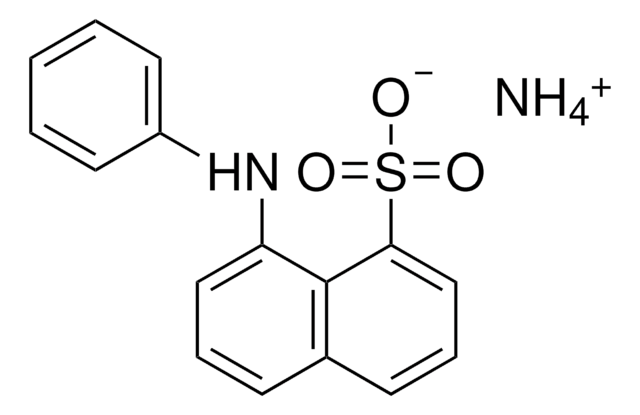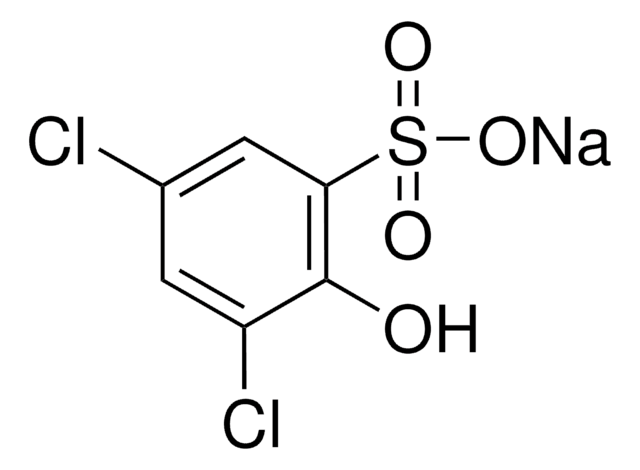10417
8-Anilino-1-naphthalenesulfonic acid ammonium salt
for fluorescence, ≥97.0% (HPLC)
동의어(들):
1,8-ANS NH4, ANSA, Ammonium 8-anilino-1-naphthalenesulfonate, N-Phenyl peri acid
로그인조직 및 계약 가격 보기
모든 사진(1)
About This Item
Linear Formula:
C16H13NO3S · NH3
CAS Number:
Molecular Weight:
316.37
Beilstein:
3581235
EC Number:
MDL number:
UNSPSC 코드:
12352106
PubChem Substance ID:
NACRES:
NA.32
추천 제품
Grade
for fluorescence
Quality Level
분석
≥97.0% (HPLC)
양식
solid
손실
≤2.5% loss on drying
mp
245-253 °C
solubility
H2O: 0.1 g/5mL, clear to very slightly hazy (hot)
NaOH: 1 N
H2O: soluble
acetone: soluble
methanol: soluble
형광
λex 388 nm; λem 470 nm in 0.1 M Tris, 0.2 M KCl, pH 9.0, BSA
SMILES string
N.OS(=O)(=O)c1cccc2cccc(Nc3ccccc3)c12
InChI
1S/C16H13NO3S.H3N/c18-21(19,20)15-11-5-7-12-6-4-10-14(16(12)15)17-13-8-2-1-3-9-13;/h1-11,17H,(H,18,19,20);1H3
InChI key
IPBNQYLKHUNLQE-UHFFFAOYSA-N
유사한 제품을 찾으십니까? 방문 제품 비교 안내
애플리케이션
ANS forms an inclusion complex with cyclodextrin. Such model systems are useful to mimic biological recognition and can be studied by measuring the change in fluorescence of free-ANS to complexed-ANS. When ANS enters the hydrophobic core of cyclodestrin, it′s fluorescence increases . Utilized in the reagent phase of a sodium-selective fiber-optic sensor. The reagent phase also contains a copper(II) polyelectrolyte, which binds to ANSA in the absence of sodium and quenches the fluorescence. In the presence of sodium, ANSA forms a cationic complex creating ion-pairs, causing it to fluoresce . ANS is often incorporated into di-block polymers and can be released by changes in the local environment (i.e., temperature, pH, etc.) . ANS is commonly used as a fluorescence probe to investigate molecular assemblies of surfactants and amphiphilic polymers because a blue shift of the emission maximum indicates the fluorophore is located in less polar media . Fluorescent probe for protein studies using methodologies such as steady-state and dynamic fluorescence measurements .
This product is an amphiphilic fluorescent probe for protein studies . Excitation of the unbound dye at 380 nm results in a low fluorescent emission with a maximum at 545 nm. The fluorescence intensity of ANS increases when the dye binds to the hydrophobic regions of a protein . The protein-ANS complex has an emission spectrum which is shifted to a broad maximum at 470 nm. At pH 8, protein causes a 40-fold increase in the relative quantum yield compared to free ANS in solution . ANS has been used to monitor protein conformational changes by binding to the hydrophobic regions of a protein , to gain new insight into protein binding interactions, often by acting as reporter or competitor ligands, to investigate the visual excitation process and structural aspects of photoreceptor cell membranes , and to probe (and disrupt) the structure of both high- and low-density lipoproteins. It has also been used as a substrate in a chemiluminescent enzyme immunoassay system and as a dye for yeast viability determination. The conformational states for apo- and holo- yeast alcohol dehydrogenase were reported under conditions of low pH using ANS fluorescence . ANS is also commonly used as a fluorescence probe to investigate molecular assemblies of surfactants and amphiphilic polymers because a blue shift of its emission maximum indicates the probe is located in less polar environment
Storage Class Code
11 - Combustible Solids
WGK
WGK 3
Flash Point (°F)
Not applicable
Flash Point (°C)
Not applicable
개인 보호 장비
dust mask type N95 (US), Eyeshields, Gloves
이미 열람한 고객
W P Le et al.
Journal of biochemistry, 119(4), 674-679 (1996-04-01)
Under conditions of low pH, the conformational states of holo-YADH and apo-YADH were examined by protein intrinsic fluorescence, ANS fluorescence, and far-UV CD measurements. The results obtained show that a low ionic strength, with the addition of HCl, the holo-
The use of fluorescent probes for the study of membranes.
A Azzi
Methods in enzymology, 32, 234-246 (1974-01-01)
M Collini et al.
Protein science : a publication of the Protein Society, 9(10), 1968-1974 (2000-12-06)
The fluorescence time decay parameters of the beta-lactoglobulin-1-anilinonaphthalene-8-sulfonate complex have been investigated under physical and chemical perturbations (2 < pH < 8 and added electrolyte 0 < NaCl < 0.5 M) to obtain new insight on the nature of the
Tianlin Wang et al.
Journal of chromatography. A, 987(1-2), 485-492 (2003-03-05)
An indirect capillary electrophoresis (CE) method was developed based on two competitive chemical equilibria for determining the stability constant of an inclusion complex formed between a cyclodextrin and a solute. 8-Anilino-1-naphthalenesulfonic acid was employed as a fluorescence probe. A linear
L D'Alfonso et al.
Biochimica et biophysica acta, 1432(2), 194-202 (1999-07-17)
Steady-state and dynamic fluorescence titrations show that: (a) the complex between beta-lactoglobulin (BLG) and 1-anilinonaphthalene-8-sulfonate (ANS) displays a heterogeneous equilibrium with large changes in the binding strength vs. pH and ion concentration; and (b) the fluorescence response of bound ANS
자사의 과학자팀은 생명 과학, 재료 과학, 화학 합성, 크로마토그래피, 분석 및 기타 많은 영역을 포함한 모든 과학 분야에 경험이 있습니다..
고객지원팀으로 연락바랍니다.










